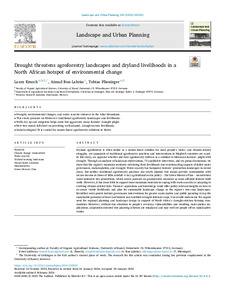| dc.date.accessioned | 2024-02-26T10:16:26Z | |
| dc.date.available | 2024-02-26T10:16:26Z | |
| dc.date.issued | 2024-02-08 | |
| dc.identifier | doi:10.17170/kobra-202402239635 | |
| dc.identifier.uri | http://hdl.handle.net/123456789/15489 | |
| dc.description.sponsorship | Gefördert im Rahmen des Projekts DEAL | |
| dc.language.iso | eng | |
| dc.rights | Namensnennung 4.0 International | * |
| dc.rights.uri | http://creativecommons.org/licenses/by/4.0/ | * |
| dc.subject | Climate change vulnerability | eng |
| dc.subject | Water scarcity | eng |
| dc.subject | Dryland farming landscapes | eng |
| dc.subject | Nature-based solutions | eng |
| dc.subject | Maladaptation | eng |
| dc.subject | Green Morocco Plan | eng |
| dc.subject.ddc | 550 | |
| dc.subject.ddc | 630 | |
| dc.title | Drought threatens agroforestry landscapes and dryland livelihoods in a North African hotspot of environmental change | eng |
| dc.type | Aufsatz | |
| dcterms.abstract | Dryland agroforestry is often hailed as a nature-based solution for rural people’s water- and climate-related struggles, yet appraisals of traditional agroforestry practices and interventions in Maghreb countries are scant. In this study, we appraise whether and how agroforestry delivers as a solution to Moroccan farmers’ plight with drought. Through an analysis of landscape observations, 75 qualitative interviews, and six group discussions, we show that the region’s mountain residents risk losing their livelihoods due to intersecting impacts of failed water governance, maladaptation, and drought. Water scarcity has hampered farmers’ production landscapes in recent years, but neither traditional agroforestry practices nor newly planted tree stands provide communities with secure income in times of little rainfall. A key agricultural sector policy – the Green Morocco Plan – incentivized water-intensive tree plantations, which added pressure on groundwater resources as more-affluent farmers built wells. However, it has done little to support most mountain residents in coping with water scarcity or adapting to evolving climate-related risks. Farmers’ aspirations and knowledge could offer policy-relevant insights on how to co-create viable livelihoods and plan for sustainable landscape change in the region’s tree-crop landscapes. Identified entry points include governance interventions for greater water justice and public spending to tap the sustainable potential of local catchments and establish drought-tolerant crops. Our results underscore the urgent need for regional planning and landscape design in support of North Africa’s drought-stricken farming communities. However, without due attention to people’s everyday vulnerabilities and resulting water-justice implications, adaptation-oriented tree-planting schemes are misplaced and may well set people off on maladaptive routes. | eng |
| dcterms.accessRights | open access | |
| dcterms.creator | Kmoch, Laura | |
| dcterms.creator | Bou-Lahriss, Aimad | |
| dcterms.creator | Plieninger, Tobias | |
| dc.relation.doi | doi:10.1016/j.landurbplan.2024.105022 | |
| dc.subject.swd | Agroforstwirtschaft | ger |
| dc.subject.swd | Afrika | ger |
| dc.subject.swd | Nordafrika | ger |
| dc.subject.swd | Lebensunterhalt | ger |
| dc.subject.swd | Umweltveränderung | ger |
| dc.subject.swd | Dürre | ger |
| dc.subject.swd | Fehlanpassung | ger |
| dc.type.version | publishedVersion | |
| dcterms.source.identifier | eissn:0169-2046 | |
| dcterms.source.journal | Landcape and Urban Planning | eng |
| dcterms.source.volume | Volume 245 | |
| kup.iskup | false | |
| dcterms.source.articlenumber | Article 105022 | |


